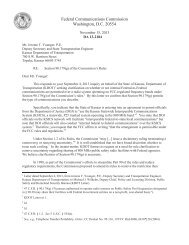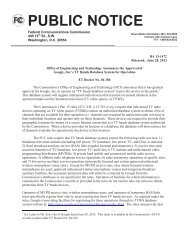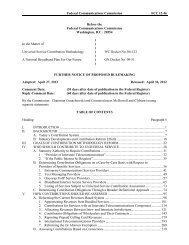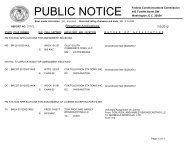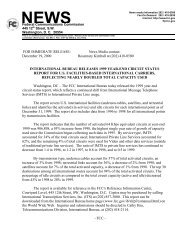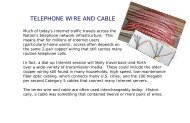You also want an ePaper? Increase the reach of your titles
YUMPU automatically turns print PDFs into web optimized ePapers that Google loves.
Page 4<br />
WHERE TO LEARN MORE<br />
Find out more about the history and technology <strong>of</strong> radio by visiting any <strong>of</strong> the following<br />
sites:<br />
• Early <strong>Radio</strong> <strong>History</strong>—http://earlyradiohistory.us<br />
• Engineering history—http://www.ieee.org/organizations/history_center/<br />
• Electromagnetic spectrum—<br />
http://imagine.gsfc.nasa.gov/docs/science/know_l1/emspectrum.html<br />
• <strong>Radio</strong> <strong>History</strong> Society—http://www.radiohistory.org/<br />
• Surfing the Aether—http://www.northwinds.net/bchris/<br />
• Marconi Calling—http://www.marconicalling.com/front.htm<br />
• Edwin Armstrong—http://users.erols.com/oldradio/index.htm<br />
• Mobile Telephone <strong>History</strong>—http://www.privateline.com/index.html<br />
• Mobile Services—<br />
http://www.ntia.doc.gov/openness/sp_rqmnts/mobile1.html<br />
• <strong>FCC</strong> Regulation <strong>of</strong> Wireless Services—http://wireless.fcc.gov/services/<br />
WIRELESS—ONE WORD, MANY<br />
MEANINGS<br />
While a rose may smell the same regardless <strong>of</strong> what it’s called, the term “wireless”<br />
has referred to distinctly different things throughout the past century. The one common<br />
characteristic among all these uses <strong>of</strong> the word is that they all describe a communication<br />
product that sends or receives information via electromagnetic waves.<br />
• 1900s—sending a wireless meant you were aboard a ship sending a telegram<br />
to the home <strong>of</strong>fice to let them know when you’d arrive.<br />
• 1920s—listening to the wireless meant you could hear the Navy’s time and<br />
weather reports, USDA’s crop and market news, as well as concerts, lectures,<br />
and sermons.<br />
• 1980s—talking on your wireless unit meant you<br />
had a cellular or PCS telephone.<br />
• 2003—using wireless likely means taking a picture<br />
using your digital 3G-enabled cell/PCS phone<br />
and sending it, along with a text message, to a<br />
friend’s Internet email address.<br />
Albert Einstein, when asked, in 1938, to explain radio, is<br />
widely reported to have said:<br />
"Y<br />
ou see, wire telegraph is a kind <strong>of</strong> a<br />
very, very long cat. You pull his tail<br />
in New York and his head is<br />
meowing in Los Angeles. Do you understand<br />
this? And radio operates exactly the same way:<br />
you send signals here, they receive them there.<br />
The only difference is that there is no cat."<br />
Marconi and Hertz used<br />
these devices in the 1880’s<br />
and 1890’s to transmit and<br />
detect radio waves.<br />
A <strong>Short</strong> <strong>History</strong> <strong>of</strong> <strong>Radio</strong><br />
TIMELINE<br />
Reginald Fessenden is the<br />
1st to transmit 1948 a program <strong>of</strong><br />
speech and music.<br />
Lee DeForest produces the<br />
“Audion,” a triode vacuum<br />
tube that allowed for amplification<br />
<strong>of</strong> radio signals.<br />
First radio transmission<br />
from an airplane.<br />
Federal regulation <strong>of</strong><br />
American airwaves begins.<br />
Amateurs had to be licensed;<br />
ships had to have a<br />
radio and trained operators.<br />
All U.S. radio stations not<br />
needed by the government<br />
are closed as WWI begins.<br />
Edwin Armstrong patented<br />
the Super Heterodyne Receiver<br />
based on work he<br />
did as an <strong>of</strong>ficer in the<br />
Army Signal Corp.<br />
The Federal <strong>Radio</strong> Commission<br />
established to bring<br />
order to chaotic airwaves.<br />
Cellular radio telephony,<br />
with call hand<strong>of</strong>f and frequency<br />
reuse, was conceived<br />
at Bell Laboratories.<br />
The <strong>FCC</strong> reallocated TV<br />
channels 70-83 for mobile<br />
radio services.<br />
The <strong>FCC</strong> permitted spread<br />
spectrum, the technology <strong>of</strong><br />
choice for many <strong>of</strong> today’s<br />
digital, commercial cellular<br />
and PCS services.<br />
The <strong>FCC</strong> reallocated spectrum<br />
at 2 GHz for emerging<br />
digital mobile services.<br />
The first cellular system<br />
using digital CDMA technology<br />
was commercially<br />
launched by QUAL-<br />
COMM.<br />
1906<br />
1906<br />
1910<br />
1912<br />
1917<br />
1918<br />
1927<br />
1947<br />
1970<br />
1985<br />
1992<br />
1995<br />
Photos courtesy <strong>of</strong>: American Institute<br />
<strong>of</strong> Physics, Emilio Segré Archives;<br />
ArrayComm; AT&T <strong>History</strong> Collection; David Massey,<br />
Perce Cox collection; Detroit Free Press; IEEE Canada; IEEE<br />
<strong>History</strong> Center; John Jenkins and the Spark Museum; Mike Katzdorn; Marconi<br />
PLC; Tesla Memorial Society; Thinkstock; and Thomas White.



